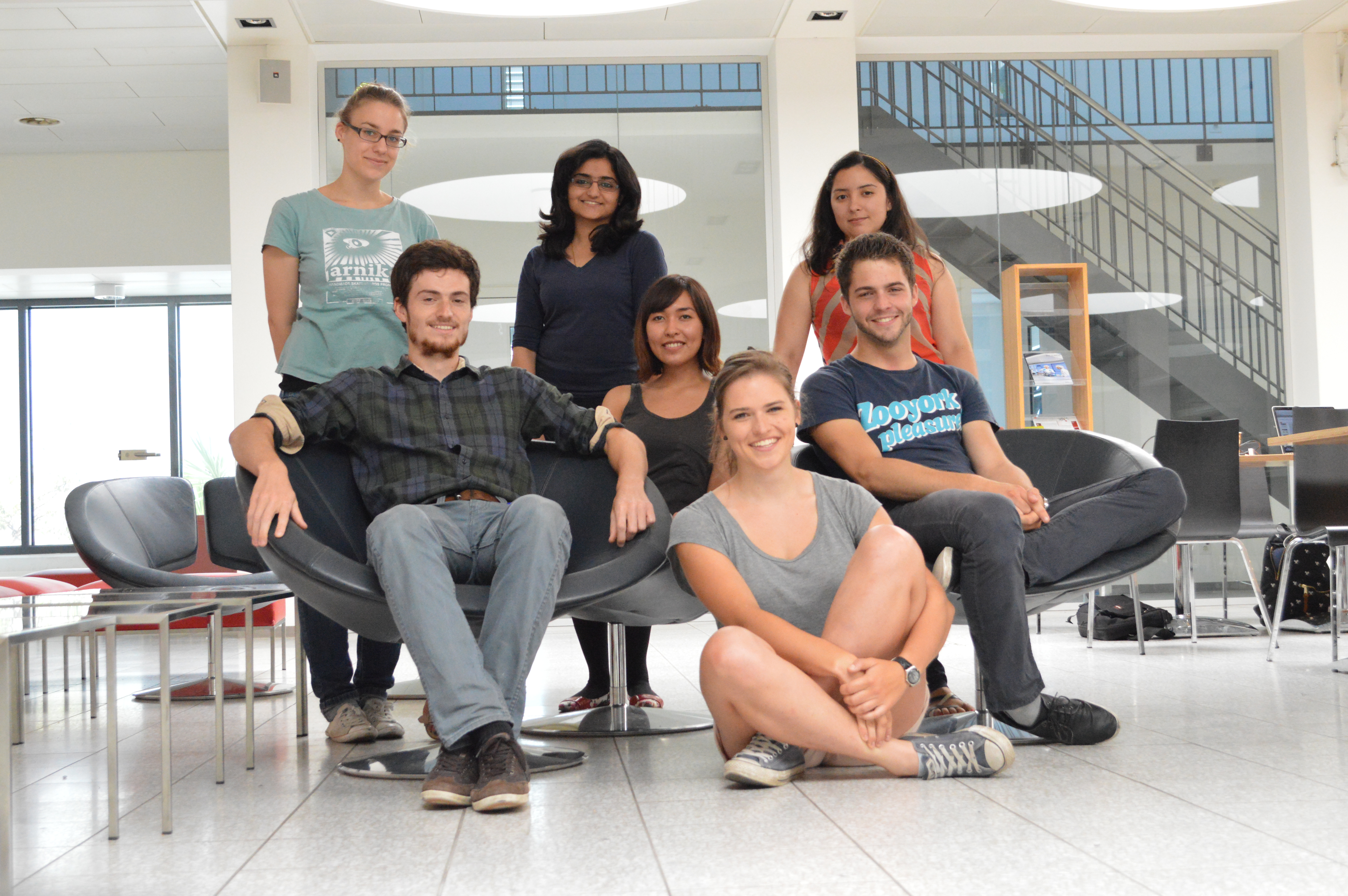Team:ETH Zurich
From 2013.igem.org
| Line 13: | Line 13: | ||
<li> | <li> | ||
<a href="/Team:ETH_Zurich/Project"><img src="https://static.igem.org/mediawiki/2013/8/8f/Minetocoli3.png"/></a> | <a href="/Team:ETH_Zurich/Project"><img src="https://static.igem.org/mediawiki/2013/8/8f/Minetocoli3.png"/></a> | ||
| - | <p style="font-size:15px" align="justify"><b>From Minesweeper to Colisweeper</b><br> We aspire to incorporate all features of the computer game Minsweeper into the biological game Colisweeper. The minefield is replaced by mine and non-mine colonies on an agar plate. Quorum sensing molecule | + | <p style="font-size:15px" align="justify"><b>From Minesweeper to Colisweeper</b><br> We aspire to incorporate all features of the computer game Minsweeper into the biological game Colisweeper. The minefield is replaced by mine and non-mine colonies on an agar plate. Quorum sensing molecule OHHL communicates between colonies which are designed to express different orthogonal hydrolases depending on the signal processed. By pipetting a colorless multi-substrate mix onto mine or non-mine colonies, color appears which indicates the next logical move for the player. If you are certain of a mine colony, you can use a second substrate solution to flag the mine. |
</p> | </p> | ||
</li> | </li> | ||
| Line 21: | Line 21: | ||
<map id="imagemap2" name="map"><area shape="poly" alt="" title="" coords="291,95,125,97,126,120,291,120,291,131,315,108,290,82,290,82" href="https://2013.igem.org/Team:ETH_Zurich/Experiments_2" target="" /><area shape="poly" alt="" title="" coords="577,163,547,171,524,205,525,250,543,288,573,299,607,284,624,250,625,211,611,182,591,164" href="https://2013.igem.org/Team:ETH_Zurich/Project" target="" /><area shape="poly" alt="" title="" coords="483,331,454,317,404,313,351,335,330,375,355,411,394,431,438,432,481,420,508,391,509,364,501,345,501,345" href="https://2013.igem.org/Team:ETH_Zurich/Experiments_3" target="" /><area shape="rect" alt="" title="" coords="225,261,358,286" href="https://2013.igem.org/Team:ETH_Zurich/Experiments_6" target="" /><area shape="circle" alt="phoa" title="PhoA" coords="116,340,19" href="https://2013.igem.org/Team:ETH_Zurich/Experiments_7" target="" /><area shape="circle" alt="GusA" title="GusA" coords="183,324,21" href="https://2013.igem.org/Team:ETH_Zurich/Experiments_7" target="" /><area shape="circle" alt="LacZ" title="LacZ" coords="158,365,22" href="https://2013.igem.org/Team:ETH_Zurich/Experiments_7" target="" /><area shape="circle" alt="LacZ" title="LacZ" coords="104,398,20" href="https://2013.igem.org/Team:ETH_Zurich/Experiments_7" target="" /><area shape="circle" alt="Aes" title="Aes" coords="189,414,22" href="https://2013.igem.org/Team:ETH_Zurich/Experiments_7" target="" /><!-- Created by Online Image Map Editor (http://www.maschek.hu/imagemap/index) --></map> | <map id="imagemap2" name="map"><area shape="poly" alt="" title="" coords="291,95,125,97,126,120,291,120,291,131,315,108,290,82,290,82" href="https://2013.igem.org/Team:ETH_Zurich/Experiments_2" target="" /><area shape="poly" alt="" title="" coords="577,163,547,171,524,205,525,250,543,288,573,299,607,284,624,250,625,211,611,182,591,164" href="https://2013.igem.org/Team:ETH_Zurich/Project" target="" /><area shape="poly" alt="" title="" coords="483,331,454,317,404,313,351,335,330,375,355,411,394,431,438,432,481,420,508,391,509,364,501,345,501,345" href="https://2013.igem.org/Team:ETH_Zurich/Experiments_3" target="" /><area shape="rect" alt="" title="" coords="225,261,358,286" href="https://2013.igem.org/Team:ETH_Zurich/Experiments_6" target="" /><area shape="circle" alt="phoa" title="PhoA" coords="116,340,19" href="https://2013.igem.org/Team:ETH_Zurich/Experiments_7" target="" /><area shape="circle" alt="GusA" title="GusA" coords="183,324,21" href="https://2013.igem.org/Team:ETH_Zurich/Experiments_7" target="" /><area shape="circle" alt="LacZ" title="LacZ" coords="158,365,22" href="https://2013.igem.org/Team:ETH_Zurich/Experiments_7" target="" /><area shape="circle" alt="LacZ" title="LacZ" coords="104,398,20" href="https://2013.igem.org/Team:ETH_Zurich/Experiments_7" target="" /><area shape="circle" alt="Aes" title="Aes" coords="189,414,22" href="https://2013.igem.org/Team:ETH_Zurich/Experiments_7" target="" /><!-- Created by Online Image Map Editor (http://www.maschek.hu/imagemap/index) --></map> | ||
| - | <p style="font-size:15px" align="justify"><b>Information Processing</b><br> Our non-mine colonies are designed to distinguish between different concentrations of | + | <p style="font-size:15px" align="justify"><b>Information Processing</b><br> Our non-mine colonies are designed to distinguish between different concentrations of OHHL that translate this information into expression of different sets of hydrolases. They are equipped with mutated LuxR promoters with different AHL sensitivities which serve as highpass filters. The promoters were created using site-saturation mutagenesis. Through mutation of the LuxR binding sites we were able to tune the promoters to different AHL affinities .</p> |
</li> | </li> | ||
| Line 30: | Line 30: | ||
<li> | <li> | ||
<a href="/Team:ETH_Zurich/GFP"><img src="https://static.igem.org/mediawiki/2013/6/63/Modeldiffusion.png"/></a> | <a href="/Team:ETH_Zurich/GFP"><img src="https://static.igem.org/mediawiki/2013/6/63/Modeldiffusion.png"/></a> | ||
| - | <p style="font-size:15px"><b>The Model</b><br> As our system is based on quorum sensing of | + | <p style="font-size:15px"><b>The Model</b><br> As our system is based on quorum sensing of OHHL, the diffusion of OHHL in the mine field is a vital part of the system. We study the diffusion in our system of a hexagonal grid format with mine and non-mine colonies with a spatio-temporal model. The model was used to validate and improve our system. |
</p> | </p> | ||
</li> | </li> | ||
| Line 37: | Line 37: | ||
<map id="imagemap2" name="#map2"><area shape="rect" alt="" title="PluxRmutations" coords="16,14,421,308" href="https://2013.igem.org/Team:ETH_Zurich/Experiments_5" target="" /><area shape="rect" alt="" title="Diffusion tests" coords="441,18,855,315" href="https://2013.igem.org/Team:ETH_Zurich/Experiments_2" target="" /><area shape="rect" alt="" title="Enzyme substrate tests" coords="23,321,444,725" href="https://2013.igem.org/Team:ETH_Zurich/Experiments_3" target="" /><area shape="rect" alt="" title="Gameplay" coords="459,317,851,724" href="https://2013.igem.org/Team:ETH_Zurich/Experiments_6" target="" /><!-- Created by Online Image Map Editor (http://www.maschek.hu/imagemap/index) --></map> | <map id="imagemap2" name="#map2"><area shape="rect" alt="" title="PluxRmutations" coords="16,14,421,308" href="https://2013.igem.org/Team:ETH_Zurich/Experiments_5" target="" /><area shape="rect" alt="" title="Diffusion tests" coords="441,18,855,315" href="https://2013.igem.org/Team:ETH_Zurich/Experiments_2" target="" /><area shape="rect" alt="" title="Enzyme substrate tests" coords="23,321,444,725" href="https://2013.igem.org/Team:ETH_Zurich/Experiments_3" target="" /><area shape="rect" alt="" title="Gameplay" coords="459,317,851,724" href="https://2013.igem.org/Team:ETH_Zurich/Experiments_6" target="" /><!-- Created by Online Image Map Editor (http://www.maschek.hu/imagemap/index) --></map> | ||
| - | <p style="font-size:15px" align="justify"><b>Experiments</b><br>Starting with characterization of the | + | <p style="font-size:15px" align="justify"><b>Experiments</b><br>Starting with characterization of the OHHL diffusion in agar plates we soon went on to test different sender- and receiver-cell set ups using GFP as a readable output. In parallel, the promoter mutagenesis and screening, as well as the testing and characterizing of different substrates on the hydrolases was done.</p> |
</li> | </li> | ||
Revision as of 19:15, 16 September 2013
Colisweeper is an interactive, biological version of the Minesweeper computer game, based on luxI/luxR quorum sensing and chromogenic enzymatic reactions. The goal is to clear an agar “minefield” without detonating mines.
Genetically engineered Escherichia coli colonies are used as sender-cells (mines) and receiver-cells (non-mines). Mines secrete the signaling molecule N-(3-oxohexanoyl)-l-homoserine lactone (OHHL) whereas non-mines process the signal. To distinguish between OHHL-levels, a library of PLuxR promoters with various sensitivities was created through site-saturation mutagenesis. High-pass filters were constructed to control the expression of different orthogonal hydrolases in non-mines, depending on the number of surrounding mines.
Additionally, the mines express their own hydrolase.A spatiotemporal reaction-diffusion model was established to evaluate and improve the system. To play Colisweeper, a colorless substrate solution is pipetted onto a colony of choice. The result is a defined color change within minutes, allowing identification of the played colony and the number of mines surrounding it.
 "
"













